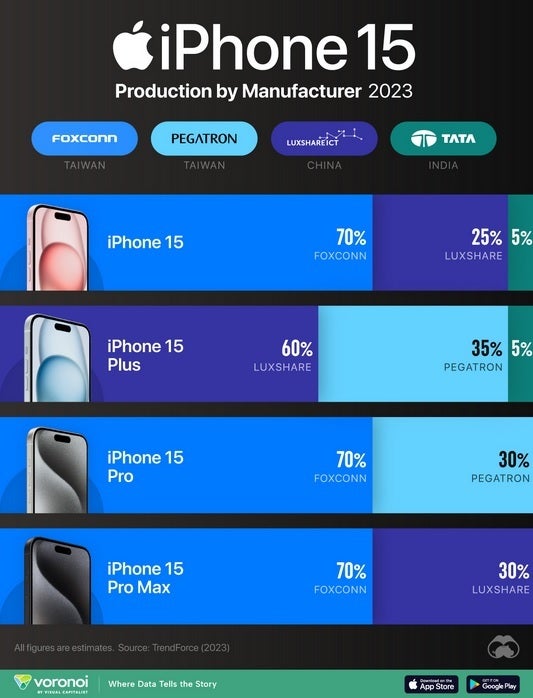Production of Apple's iPhone 15 series broken down by the four contract manufacturers

Apple counts on four contract manufacturers to assemble the different iPhone variants. The one firm that arguably is the most associated with Apple is Taiwan-based Foxconn and according to Visual Capitalist, citing data compiled by TrendForce, Foxconn is responsible for the production of 70% of the iPhone 15 model. 25% of iPhone 15 units come off of Luxshare's assembly lines. That contract manufacturer is based in China. The remaining 5% are built by India's Tata.
The breakdown of iPhone 15 Plus production starts with the 60% assembled by Luxshare. Taiwan's Pegatron manufactured 35% of the 6.7-inch non-Pro iPhone models manufactured last year. The remaining 5% was assembled by Tata.
Turning to the premium iPhone 15 Pro series, this model is made by only two contract manufacturers. Foxconn and Pegatron build 70% and 30% of the iPhone 15 Pro models respectively. As for the iPhone 15 Pro Max, Foxconn is responsible for the assembly of 70% of the top-of-the-line units while Luxshare builds the remaining 30%.

The percentage of each iPhone 15 series model made by each contract manufacturer last year
You might have seen the Foxconn name and might even be aware of Pegatron. Luxshare is the only contract manufacturer headquartered in mainland China to build iPhone units. But you can see that Apple has more faith in Foxconn since it assembles 70% of the iPhone 15 Pro series. As for India's Tata, it is the largest conglomerate in the country with subsidiaries that include Tata Motors, Tata Steel, and Air India. The four contract manufacturers receive components from over 200 suppliers and must put all of them together to create one of the four iPhone 15 models.
Apple has been reportedly looking to move the assembly of the iPhone out of China to avoid political issues and trade wars. The tech giant has been looking to expand production of the handset in India and other countries mentioned as possible landing spots for iPhone production facilities include Vietnam, which has become a major tech center, and Mexico. Whichever country Apple chooses must be close to a supply chain that can deliver components in the quality and quantity required by Apple.
Follow us on Google News












Things that are NOT allowed:
To help keep our community safe and free from spam, we apply temporary limits to newly created accounts: